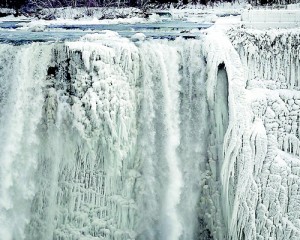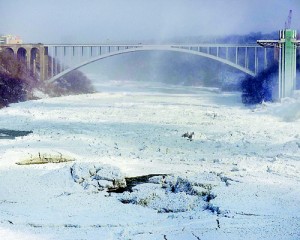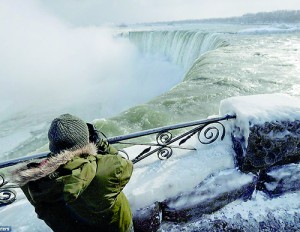Sunday Times 2
Polar Vortex turns Niagara Falls into a frozen wonderland
View(s):
A collection of spectacular photographs have shown the moment the U.S. side of the famous falls froze before they could reach the bottom. Reuters
The record-breaking chill across the U.S. and Canada was so frigid it literally stopped Niagara Falls in its tracks.
A collection of spectacular photographs have shown the moment the U.S. side of the famous falls froze before they could reach the bottom.
Thankfully, the freezing air and ‘polar vortex’ that turned the cascading water to ice — and affected about 240 million people in the U.S. and southern Canada — will depart during the second half of this week, and a far-reaching January thaw will begin, according to AccuWeather.com.
The incredible pictures show frozen mist coating the landscape around Prospect Point at Niagara Falls State Park and the Rainbow Bridge is seen with solid ice below it.
Tuesday was a day of record-setting cold in Niagara, with the mercury bottoming out at a chilling -2F. Combined with the wind chills, it felt like -20F.
One would think the icy cold would keep tourists away, but those who enjoy taking

In the incredible pictures, the Rainbow Bridge is seen with solid ice below it. Reuters
photos rugged up to snap the conditions, producing exceptional images they wouldn’t otherwise have an opportunity to capture.
The natural wonder should be looking more like itself come Saturday when temperatures are forecast to be in the 50s, according to Environment Canada.
The ‘unprecedented’ amounts of ice in the upper Niagara River, caused by the freezing conditions, caused a so-called ice jam and in turn flooding on Grand Island and Cayuga Island in Niagara Falls.
According to historical records, during only one year, 1848, has freezing weather caused the thousands of cubic feet of water per second flowing over the Niagara Falls to run dry, an event thought to have been caused by ice jamming and damming upriver, according to environmentalgraffiti.com.
© Daily Mail, London

Tuesday was a day of record-setting cold in Niagara, with the mercury bottoming out at a chilling -2F. Combined with the wind chills, it felt like -20F Reuters

